The BlackBerry PlayBook Review
by Anand Lal Shimpi on April 13, 2011 9:00 PM EST- Posted in
- Tablets
- Smartphones
- RIM
- BlackBerry
- PlayBook
- Mobile
I suppose it's fitting that I should be the one to write our PlayBook review. Before Android and the iPhone, there were two mobile platforms/devices that I was hugely fond of: the Palm V and my BlackBerry. In fact, it wasn't until the iPhone that I finally let go of my last BlackBerry - moving on from the email era into the smartphone age.
Today's BlackBerry is of course very different than the devices I used in college. And the PlayBook is unlike anything RIM has ever done.
I don't believe any tablet maker has perfected the formula just yet. I made that abundantly clear in our review of the iPad 2. While you can't argue that Apple is the forerunner in the smartphone based tablet space, over the long term I still believe this is anyone's game. Remember, the leaders in the early days of the PC industry weren't the ones who ultimately dominated the mature market.
What follows is our review of RIM's first attempt at building a tablet. The PlayBook is far from perfect, but there's a foundation here that can be built upon if RIM has a good roadmap and good execution. And if you're a BlackBerry user, there's a lot of synergy to exploit.
| BlackBerry PlayBook Pricing Comparison | |||||
| 16GB | 32GB | 64GB | |||
| WiFi | $499 | $599 | $699 | ||
Let's get to it.
The Hardware
If we view the primary difference between the first and second generation of smartphone based tablets as being ergonomics and performance, the PlayBook falls squarely in between the two.
At 10mm thick the PlayBook (7-inch display) is more iPad 1 (9.7-inch) or Xoom (10.1-inch) than iPad 2 or Galaxy Tab 8.9, but what RIM lacks in thinness it makes up for in overall size. The PlayBook is an almost-pocketable tablet. Bigger than the 5-inch Streak and even bigger than the 7-inch Galaxy Tab, the PlayBook isn't a pain to port around. The PlayBook is small enough to snugly fit inside the outer pocket of a long men's winter coat or a lady's purse. While I definitely don't carry my iPad everywhere, if it were more functional I could see carrying the PlayBook with me more often than any other tablet.
The PlayBook's styling is modest, even for BlackBerry standards. The front has a single BlackBerry logo along the bottom bezel and a visible camera lens but that's it. Around back you've got RIM's logo, a larger lens for the rear-facing 5MP camera sensor and a sea of black.
The only buttons on the device are along the top of the PlayBook: power, volume down, pause/play and volume up. The power button is flush with the surface of the PlayBook's edge. You basically need a pointy finger nail (which I typically don't have) to press it easily and as a result the power button was pretty much useless to me. If you can manage to hit it the power button will lock the PlayBook, otherwise you'll have to leave the tablet idle until it automatically goes into standby. RIM tells me that final versions of the PlayBook will have this power button raised by 0.8mm, enough to make it easily clickable.
Press and hold the power button and you'll be greeted with a PC-like choice to either power off the PlayBook or restart it. I'm not sure how frequently RIM expects you to do the latter, but when testing it's a nice feature to have.
The volume up/down buttons work as expected, although the volume level itself doesn't seem to be very linear. There's a single 1/8" headphone jack up top, near a port for the PlayBook's microphone.
The PlayBook features a pair of pretty loud stereo speakers on the front of the device. Being used to the iPad's single speaker, the PlayBook's two speakers are nice.
Charging is always an issue on these USB devices. You can take Apple's approach and charge over USB, which unfortunately can take a while to fill up a tablet's battery. You also run into issues with older computers that don't support the USB Charging spec, resulting in charging-only-while-sleeping like the iPad. Then there's Motorola's approach with the Xoom where you don't charge over USB but have a dedicated port for an AC adapter. Charging times are significantly reduced but now you need to carry around an extra adapter with you wherever you go. RIM arrived at what's quite possibly the best solution. The PlayBook will charge over USB and it also features a higher amperage quick-charge port for use with some of its accessories.
The battery is of course not removable and there's no USB port or SD card reader.
The Form Factor
The PlayBook is only slightly larger than Samsung's 7-inch Galaxy Tab and maintains the same 7-inch screen size (albeit with a functional border around the screen). Given my complaints about current tablets not being incredibly portable compared to a smartphone, you'd think that I'd love the PlayBook's form factor. To be honest, for portability, I do.
| Tablet Specification Comparison | |||||
| Apple iPad 2 | BlackBerry PlayBook | Motorola Xoom | |||
| Dimensions | 241.2mm x 185.7mm x 8.8mm | 194mm x 130mm x 10mm | 249.1mm x 167.8mm x 12.9mm | ||
| Display | 9.7-inch 1024 x 768 | 7-inch 1024 x 600 | 10.1-inch 1280 x 800 | ||
| Weight | 601g (WiFi only) | 425g | 730g | ||
| Processor | 1GHz Apple A5 (2 x Cortex A9) | 1GHz TI OMAP 4430 (2 x Cortex A9) | 1GHz NVIDIA Tegra 2 (2 x Cortex A9) | ||
| Memory | 512MB | 1GB | 1GB | ||
| Storage | 16GB up to 64GB | 16GB up to 64GB | 32GB + microSD card | ||
| Pricing | $499 up to $829 | $499 up to $699 | $599 - $799 | ||
While I'm almost never tempted to bring the iPad with me when I'm going around town, the PlayBook is a far easier sell. It's almost pocketable (and actually pocketable if I'm wearing a big jacket) and isn't too heavy.
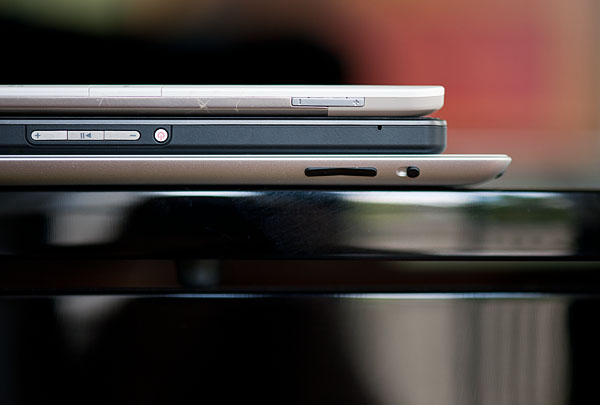
From top to bottom: Amazon Kindle 2, BlackBerry PlayBook, Apple iPad 2
Even when I'm not out and about, the PlayBook is quite usable as a content consumption device. In portrait mode fonts are a bit too small for me to read comfortably on the couch but in landscape it works well as a reddit browsing machine.
It's in the couch-lounging usage model that the PlayBook does fall short of the iPad or Xoom. But in terms of portability the PlayBook is clearly a much better balance of functionality and mobility. If you read between the lines you'll come to the same conclusion I have: neither the PlayBook nor the iPad is the perfect form factor for a tablet. Further more, I'm not sure there is a single perfect tablet form factor.
Apple tends to be a one-size-fits-all company when it comes to iOS. You want a smartphone? That'll be a 3.5-inch screen on an iPhone. Want a tablet? 9.7-inch iPad. It's interesting given how carefully Apple selected its four notebook sizes: 11, 13, 15 and 17-inches.

Clockwise: Apple iPad 2, Amazon Kindle 2, BlackBerry PlayBook in Convertible Case
Ultimately I don't think tablets will fall into the one-size-fits-all category. Instead I believe they're ultimately headed for some sort of a convergence with netbooks or notebooks. Today that's difficult to see because they lack a common hardware ISA, OS and even apps, but you don't have to look too far into the future to see those problems going away.
While I appreciate the PlayBook's portability and would definitely carry it around more than an iPad, it's not as nice to use laying back on a couch. The screen is too small to comfortably read in portrait mode and even in landscape things can get a bit cramped.
RIM's market research shows a clear preference for portability, hence the PlayBook's introductory 7-inch form factor. However RIM also pointed out that the BlackBerry comes in all shapes and sizes, indicating that the PlayBook would ultimately be available in different form factors as well. RIM also indicated that the 7-inch PlayBook may not be the smallest size offered either. Clearly RIM views the tablet market much like the notebook market: there will be ultraportables and there will be workhorses, with tons of choice in between. The 7-inch PlayBook is merely a starting point. Assuming RIM can fund the projects, we'll likely see both larger and smaller siblings in the future.


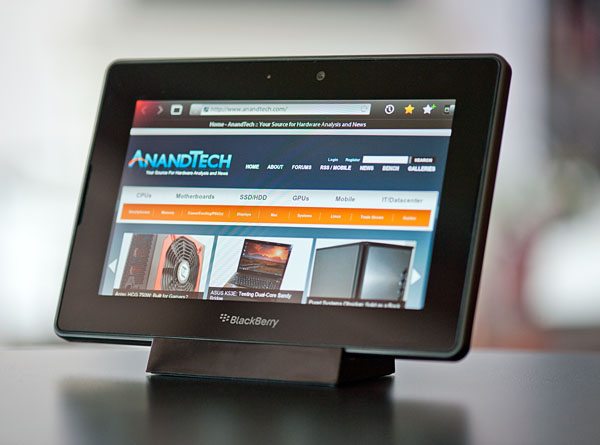
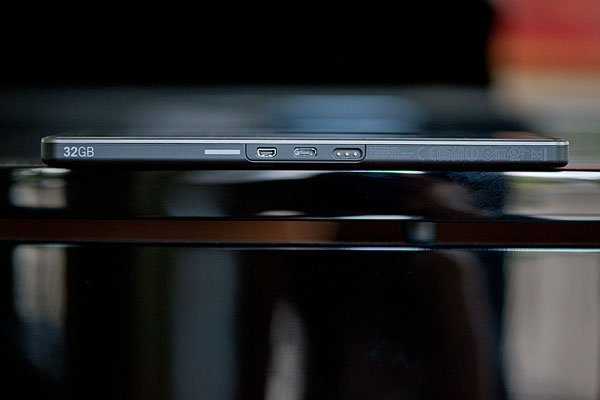
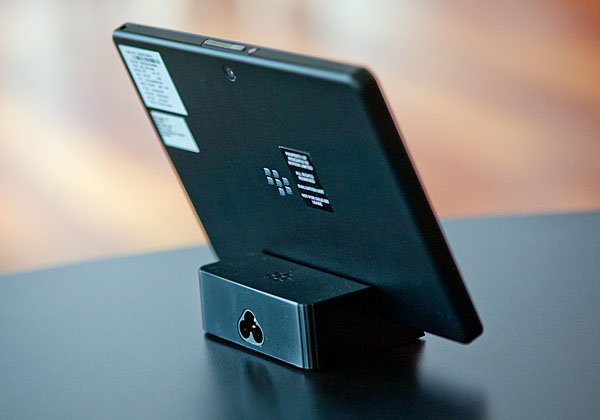
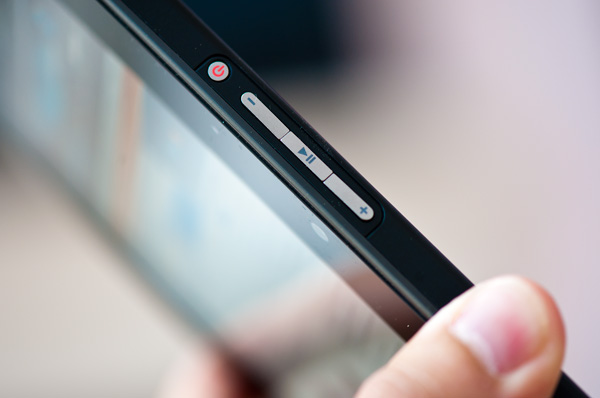
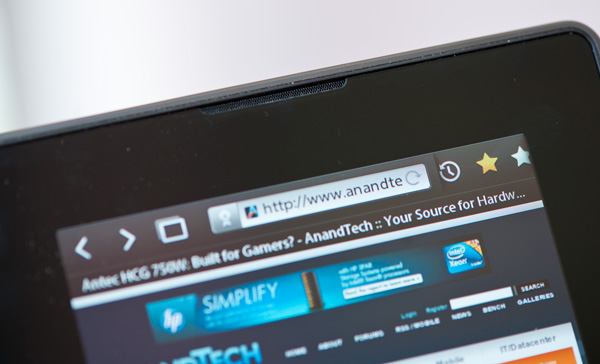








77 Comments
View All Comments
Andrew911tt - Thursday, April 14, 2011 - link
You have the Xoom at a price of $799 but you can get the 32 GB wifi version for $599http://www.amazon.com/MOTOROLA-XOOM-Android-Tablet...
MTN Ranger - Thursday, April 14, 2011 - link
Excuse my off topic question.Anand, I notice you use Lafayette Village in your videos a lot. Do you live/work near there? We enjoy having drinks at the Village Grill and my wife loves the Upper Crust Bakery. I have taken photos there and think the architecture is great.
Anand Lal Shimpi - Thursday, April 14, 2011 - link
I'm not too far from there. It's the most interesting thing that I can photograph quickly outside of my dogs playing :)Take care,
Anand
jensend - Thursday, April 14, 2011 - link
I'm serious- this is probably the best commercial OS out there. Of course, these days most people judge an OS mostly by its included applications and the collection of software written for it, which doesn't look so good for QNX, but as far as the actual OS is concerned QNX is extremely well designed.baba264 - Friday, April 15, 2011 - link
I would tend to agree.I was very impressed upon reading all the nice features that this OS has and that are still lacking in mainstream PC OS.
The the tight kernel, the sandboxing, the thread management, the corruption protection all of it sounded real nice. Of course since it wasn't the focus of the article, many question remain, especially performance wise, still it sounded like an impressive work.
vision33r - Friday, April 15, 2011 - link
Because people are used to the iPhone / iPad and App Store being the standard.QNX is a good OS, it is tight and lean. There won't be a fragmentation problem like Android has.
The only problem is that RIM will restrict the device's functionality so that it cannot replace a Blackberry device and risk losing lucrative smartphone sales.
B3an - Friday, April 15, 2011 - link
"You can't really hover to expose controls with a touchscreen so what you end up doing is a lot of quick tapping to try and bring up controls, change the setting you want and get back to playing the video. It's frustrating and doesn't work all of the time. None of this is RIM's fault, but now that tablets are at the point where they can start to behave like notebook/desktops web developers will have to rethink the way they build websites. "I'm a web designer and specialise in interactive websites and apps, but touch screens have the ability to hold this area back and make it less elegant/messy for other devices with no touch.
The problem is not with web sites designed for non-touch devices but the need for a touch device to support hover in some way. For instance this could be done if a touch screen could detect a finger hovering over an area of the screen within say half an inch of the screen surface. That could work well if done right.
As sites get more interactive and advanced hover controls in the UI make more and more sense. because of interface complexity rises and the need for more buttons and stuff all over the place.
The thing with Flash is that being as it's far more capable than HTML5 for interaction (and with pretty much anything else too) is that it's Flash that is more likely to use hover controls in some form. But some HTML5 things are stating to use it, like the default skinned Chrome HTML5 video player for instance. Hover just makes perfect sense for certain things and touch screens need to fix this, not us web designers.
ElementFire - Friday, April 15, 2011 - link
This is a seriously well-wrought review. I'm especially glad you dedicated an entire section to Bridge, and addressed the free tethering question. As you stated, this is huge (assuming the carriers permit it), as it's the closest thing to truly unlimited browsing data plans (for no additional charge!) as we'll get now.It's a pity that Android apps need to be re-signed by RIM before they'll run. It makes sense from a security perspective (you don't want malicious apps running amok on an enterprise platform), but I'd have preferred if RIM had severely limited Android VM capability and allowed all apps to *try* to run, rather than requiring re-signing; the vast majority of Android app-developers won't have the impetus to resubmit their apps to yet another platform holder.
The last point I wanted to make was video conferencing: it's a serious letdown to only ship with point-to-point video chat (and even then, only between PlayBook owners!). If you're aiming at the enterprise, I'd expect VoIP/SIP capability and the ability to run WebEx natively. Does the PlayBook support any implementation of Java Runtime Environment?
name99 - Saturday, April 16, 2011 - link
"Pretty much no smartphone or tablet we've tested is particularly speedy over WiFi. Even the Motorola Xoom, at the top of our performance chart, manages a meager 36Mbps. Part of this has to do with the fact that all of these devices are power rather than performance optimized and part of it has to do with NAND performance limitations."Is this not simply a reflection that none of these devices use 40MHz wide channels, they all stick to 20MHz wide channels? I'm not certain about this, but given how the numbers cluster, I would bet this is the case.
(And, of course, none of these devices use multiple antennas for wifi.)
The flash has nothing to do with it. iPad flash can write sustained at a little under 20MB/s (ie 160 Mbs/s) and I imagine other tablets have similar specs.
In theory, the most power efficient way to run wifi is to do get your transmissions done as fast as possible --- in other words use 40MHz and multiple antennas and run at the maximum data rate possible. Of course this requires that the chips being used be maximally efficient in their overhead, so that essentially all power is being burned in RF transmit, not in the receivers, the decode logic and so on. It may well be that the chips supporting 40MHz, let alone MIMO, simply haven't been around for long enough to have their power usage tuned to where the 20MHz chips are.
tipoo - Sunday, April 17, 2011 - link
Most routers and laptops will default to 20MHz anyways.